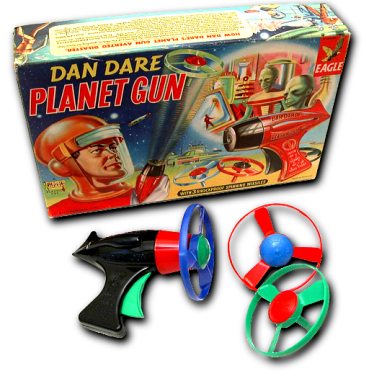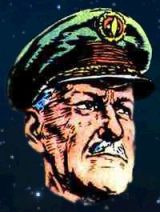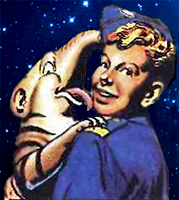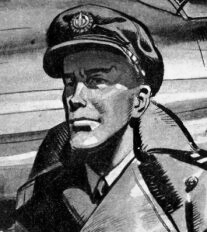 |
| © Copyright Zac Sawyer 2015 |
to view images full size open image in a new tab
Most of this DAN DARE blog has been deleted - because some individual took exception to some comments about Hampson and Morris, and some of the characters and stories.This 'Eagle anorak' suggested that there has been a breach of copyright - obviously not Hampson's copyright as he was never allowed to copyright any of his material.Most of the images on the blog were copyright material from Zac Sawyer and Peter Crawford, and were supplied with permission.The blog has been republished somewhere else on the internet - so see if you can find it.This section is from the biography of Peter Crawford ('So Long Ago So Clear') and is all under his copyright (text and images), and other sections are now being added - so please be patient.
EXCERPT FROM
‘SO LONG AGO – SO CLEAR‘
(Peter’s Biography)
THE FUTURE BREAKS IN – 'THE EAGLE'
Friday, the fourteenth of April, 1950, when Peter was five years old, was one of the most important days in that young boy’s life.
That was the day that the first copy of the Eagle comic appeared, and was dropped, along with the Middlesex Chronicle, through the letter-box of fifty-five Pears Road, by the paper boy.
 |
| © Copyright Peter Crawford 2014 |
In the 1950s the Eagle was a completely new kind of boy’s comic.
The Eagle was the brainchild of the Reverend John Marcus Morris - and to understand the ethos behind the original Eagle, and of course Dan Dare, you need to know about Marcus Morris.
Morris was a rather unconventional, Anglican minister, who had started a parish magazine called ‘The Anvil’.
Morris was unconventional in the sense that as a young man he took to canoeing down the Danube with a young friend in the nude; had a forty a day cigarette habit; and was rather over fond of alcohol.
In addition, in later life, when he became successful, he regularly indulged in exaggeratedly long business lunches at the best London hotels, and despite being married with children, appeared to see nothing wrong in getting involved with a string of mistresses.
Before succumbing to such temptations, however, Morris developed high hopes for the Anvil, intending it to become a national magazine with the purpose of promoting Christian values in post-war Britain.
Unfortunately for post-war Britain, but probably fortunately for a whole generation of boys, the magazine was a complete flop.
 |
| Morris' 'Healthy Values for Boys' Illustration from the Eagle - 1950s |
 |
| Morris' 'Healthy Values for Boys' Illustration from the Eagle - 1950s |
At the time the news-stands were awash with what were generally known as ‘Horror Comics’.
These were essentially imports from the USA, which typically featured stories involving violence, brutal torture, excessive and unnecessary knife and gun play, physical agony, and gory and gruesome crime.
Not surprisingly they were popular with many children, but were a considerable cause of concern to many adults.
Eventually a press campaign was mounted against these publications, and there was even an episode of Britain’s most popular BBC television ‘soap’, the ‘Grove Family’, which featured the families’ youngest child suffering nightmares after reading such a comic.
 |
| Grove Family |
Rev Morris had started work on his new style of comic, which was intended to undo any damage to young minds for which the dreaded ‘horror comics’ may have been responsible.
As a failed independent magazine publisher it was obvious that Morris needed professional help if he was to make a success of his new boy’s comic, and eventually, with the genius of Frank Hampson, the Eagle was published by the Hulton Press.
Now Dan Dare preoccupied our Peter right up until 1959
As a failed independent magazine publisher it was obvious that Morris needed professional help if he was to make a success of his new boy’s comic, and eventually, with the genius of Frank Hampson, the Eagle was published by the Hulton Press.
 |
| © Copyright Peter Crawford 2014 |
Dan Dare, the space hero of the ‘Eagle’ comic, continued to preoccupy and fascinate Peter, and for the Christmas of 1954 he had managed to nag Jane and John into buying him a ‘Space Station Communications Centre’, which was one of the most elaborate and expensive of the Dan Dare spin-offs that were then flooding the toy shops.
 |
| © Copyright Peter Crawford 2014 |
THE COMIC
There were two large color pages of his story per issue.
The artwork was of a high quality, the product of artists in a studio called the 'Old Bakehouse' in Churchtown, Southport, Lancashire
The artwork was of a high quality, the product of artists in a studio called the 'Old Bakehouse' in Churchtown, Southport, Lancashire
It had scale models of spaceships, and models in costume as reference for the artists.
Occasionally, Eagle incorporated "centrefolds" of the fictional spaceships, such as Dan's ship the 'Anastasia', reminiscent of cutaway drawings of aircraft in aviation magazines or even Eagle itself.
The story-lines were long and complex, sometimes lasting more than a year
Later, artwork was produced at a studio in Hampson's house in Epsom, Surrey, where his production line techniques were continued.
Attention was paid to scientific plausibility, the science fiction luminary Arthur C. Clarke acting as science and plot adviser to the first strip
The stories were set mostly on planets of the solar system presumed to have
extraterrestrial life and alien inhabitants, common in science fiction before space probes of the 1960s indicated that the most likely worlds were lifeless.
The first story began with Dan Dare as pilot of a flight to Venus.
Dan Dare became the most popular fictional character in British history during the 1950's, helping the Eagle to sell around three-quarters of a million copies each week and with an at-the-time unprecedented amount of merchandise produced.
The main reasons for this spectacular popularity were the sheer quality of the story scripting, the brilliant characterisations and the absolutely superb artwork - to this day the 1950's Dan Dare strips are among the very best the world has ever seen.
The first story began with Dan Dare as pilot of a flight to Venus.
Dan Dare became the most popular fictional character in British history during the 1950's, helping the Eagle to sell around three-quarters of a million copies each week and with an at-the-time unprecedented amount of merchandise produced.
The main reasons for this spectacular popularity were the sheer quality of the story scripting, the brilliant characterisations and the absolutely superb artwork - to this day the 1950's Dan Dare strips are among the very best the world has ever seen.
 |
| Pete's Dan Dare's Spacebook 1954 © Copyright Peter Crawford 2014 |
Hampson himself was not just the artist responsible for drawing Dan's adventures, and supervising the artists and studio where those drawings were made - he was also the creator of all the characters in the stories, and also planned out many of their adventures.
To understand 'Dan Dare' it is essential to understand Frank Hampson.
Originally Colonel Dare was to have been a ‘space padre’, in deference to the Rev Morris.
It soon became clear, even before the first publication, that this was not only an impractical character to be the mainstay of the comic, but it was also highly unlikely that boys, to whom the comic was aimed, would be able to identify with such an improbable character.
 |
| © Copyright Peter Crawford 2014 |
Colonel Dare, now minus the ‘dog-collar’, was supposedly born in Manchester in 1967, and he attended Rossal School, eventually becoming School Captain, (as our Peter did), and later went to Trinity College Cambridge.
His hobbies were listed as cricket, fencing, riding, painting and model making.
In the 1950s, of course, any boy or man worth his salt was expected to have a number of worthwhile and improving hobbies. |
| © Copyright Peter Crawford 2014 |
His side-kick was a very different individual.
Albert Fitzwilliam Digby was short and fat, unlike the tall, athletic Dan.
Digby was Dan’s ‘bat-man’.
He was born in Wigan in 1960, and had been brought up by his aunt Anastasia.
Unlike the other characters, Digby was married with four children, Frances, Albert, Mary and Anna.
He was only described as having two hobbies; football and sleeping, but then Digby was a stereo-typical working-class northerner.
 |
| © Copyright Peter Crawford 2014 |
Dan’s boss was Sir Hubert Guest, (modelled, in appearance, on Frank Hampson’s father, ‘Pop’), and was the ‘upper class’ commander of the Space Fleet, who was supposedly born in 1943.
Grey haired and distinguished, with a neatly clipped RAF style moustache, Sir Hubert was undoubtedly Dan’s father figure.
There was only one female in the Dan Dare series, and that was Professor Jocelyn Peabody, (who was based on Greta Tomlinson – one of Hampson’s artists).
 |
| © Copyright Peter Crawford 2014 |
Miss Peabody was young, slim and very attractive, as well as being very intellectual – well she was a professor and a qualified space pilot !
 |
| © Copyright Peter Crawford 2014 |
Strangely, none of the men, Dan, Hank – an American, Pierre – a Frenchman, or Lex O’Mally – an Irish naval commander, took the slightest romantic interest in her, and always treated her a just ‘one of the boys’.
And speaking of boys, there was one boy in the team – Christopher Philip Spry.
Christopher Spry was born in Middlesex, but no date was ever given. In the stories he appears to be about thirteen or fourteen.
Christopher; always known as ‘Flamer’, first appeared in the ‘Eagle’ on 28th May, 1954, when our Peter was about eight years old.
Of course, Hampson was quite clever in introducing a character into the stories who was relatively close to the readers’ own age, & with whom the reader could easily identify.
‘Flamer’ himself was based on Hampson’s son, Peter – another coincidence of names which take us back to Barrie’s eponymous hero – (editor’s note – this is a reference to Peter Pan).
Just as Hampson thought of himself as Dare, and thought of his father ‘Pops’ as Sir Hubert, so Peter Hampson became the inspiration and literally the model – in the sense of artist’s model – for ‘Flamer’ Spry.
Now there were some strange similarities between Flamer Spry, our Peter and the other Peter – (that is Peter Pan), – but we will need to supply some background information for those readers who are not familiar with the Dan Dare stories, in order to make these similarities clearer.
 |
| © Copyright Peter Crawford 2014 |
‘Flamer’ firs t appears in the Eagle in a story called ‘Lost in Space’, when he accidentally launches a spaceship containing himself, another, slightly older boy called Steve Valiant, (both are cadets at the Astral College) , and an old mechanic called ‘Groupie’.
.
The trio are captured by the Mekon, (Dan’s arch-enemy), but eventually all turns out well, as it inevitably must.
What is strange is that, although Sir Hubert Guest is distraught at the thought of the two cadets being ‘lost in space’, no mention is made of any actions to contact the boys’ parents or relatives.
As already stated, everything turns out fine in the end, and in subsequent stories Steve Valiant disappears from the scene.
.

In ‘The Man from Nowhere’, Flamer appears in the opening scenes, wherehe is atte nding a gala reception at the Venusian Embassy in London, along with Steve Valiant, Dan, Digby and Sir Hubert.
He then disappears, during the initial flap, when an alien spaceship suddenly appears in earth orbit.After the spaceship crashes into the Pacific, Flamer, on the insistence of Commander Lex O’Mally, accompanies Dan and Digby on an underwater rescue mission in the Tuscarora Deep.
He then disappears from the story again, while the alien survivors, the Crypts led by Lero, who have come to Earth seeking help in their fight against the Phants, are rescued.
The story then continues as the ‘Terra Nova’ trilogy, which is the point where Frank Hampson, and Flamer leave the Dan Dare saga. |
| The 'real' Flamer Spry © Copyright Zac Sawyer 2014 |
Now granting that Flamer Spry is just an imaginary character in a boys’ comic, there are still aspects about this young man that impinge on Peter’s story.
Firstly, like Peter, Flamer’s origins are completely unknown.
He is given no date of birth, unlike all the other characters, and all we know is that Flamer was born in Middlesex, which strangely enough is where Peter lived.
Equally, we do not know if Flamer had any brothers or sisters, or even who his parents were.
Was he an orphan, like Peter ? – certainly there were no parents worried and grieving when Flamer is captured by the evil Mekon, or any parents to raise any objections when Sir Hubert decided to allow the boy to go off on a long and dangerous missions out into the unknown, – or parents to consult when Dan decided to take the boy on a holiday to Venus.
Names are strange things, and are often involved in inexplicable co-incidences.
Flamer’s first name was Christopher, and as we shall see there was, later on, a very important person called Christopher in Peter’s life.
But also Flamer was based, in part, on Peter Hampson, Frank Hampson’s young son, and so he shared a name with our Peter, and, looking further back, with Peter Pan.
Flamer’s first name was Christopher, and as we shall see there was, later on, a very important person called Christopher in Peter’s life.
But also Flamer was based, in part, on Peter Hampson, Frank Hampson’s young son, and so he shared a name with our Peter, and, looking further back, with Peter Pan.
And like Peter Pan, Flamer never grew up. When Flamer first appeared in the Eagle, in ‘Prisoners of Space’, he was about thirteen or fourteen, and that was in 1954. In 1960, at the end of ‘Terra Nova’, when he should have been twenty, he was still thirteen or fourteen !
 |
| © Copyright Peter Crawford 2014 |
more about Pete's involvement with Dan dare to come........



